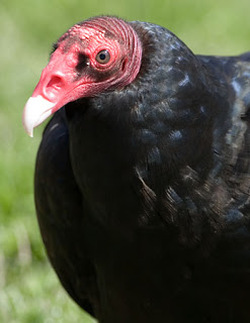Igor our Turkey Vulture

Turkey Vulture (Cathartes aura) If you've gone looking for raptors on a clear day, your heart has probably leaped at the sight of a large, soaring bird in the distance perhaps an eagle or osprey. But if it's soaring with its wings raised in a V and making wobbly circles, it's likely a Turkey Vulture. These birds ride thermals in the sky and use their keen sense of smell to find fresh carcasses. They are a consummate scavenger, cleaning up the countryside one bite of their sharply hooked bill at a time, and never mussing a feather on their bald heads.
Turkey Vultures are large dark birds with long, broad wings. Bigger than other raptors except eagles and condors, they have long "fingers" at their wingtips and long tails that extend past their toe tips in flight. When soaring, Turkey Vultures hold their wings slightly raised, making a ‘V’ when seen head-on.
Turkey Vultures appear black from a distance but up close are dark brown with a featherless red head and pale bill. While most of their body and forewing are dark, the undersides of the flight feathers (along the trailing edge and wingtips) are paler, giving a two-toned appearance.
Notes
Turkey Vultures are large dark birds with long, broad wings. Bigger than other raptors except eagles and condors, they have long "fingers" at their wingtips and long tails that extend past their toe tips in flight. When soaring, Turkey Vultures hold their wings slightly raised, making a ‘V’ when seen head-on.
Turkey Vultures appear black from a distance but up close are dark brown with a featherless red head and pale bill. While most of their body and forewing are dark, the undersides of the flight feathers (along the trailing edge and wingtips) are paler, giving a two-toned appearance.
Notes
- The Turkey Vulture uses its sense of smell to locate carrion. The part of its brain responsible for processing smells is particularly large, compared to other birds. Its heightened ability to detect odors—it can detect just a few parts per trillion—allows it to find dead animals below a forest canopy.
- The Turkey Vulture maintains stability and lift at low altitudes by holding its wings up in a slight dihedral (V-shape) and teetering from side to side while flying. It flies low to the ground to pick up the scent of dead animals.
- Not everyone sees vultures as a creepy harbinger of death—many see them as sacred for their cleanup role. Tibetan Buddhists practice “sky burials,” where animals, usually vultures, consume their dead. Similarly, Zoroastrians offer their dead to be consumed by vultures on a raised platform, called a dakhma. They regard vultures are precious animals that release the soul from the body. However, in parts of urban India, where vultures have become scarce because of accidental poisoning by a livestock anti-inflammatory drug, not enough vultures remain to meet the demand and some people have turned to burial.
- The word vulture likely comes from the Latin vellere, which means to pluck or tear. Its scientific name, Cathartes aura, is far more pleasant. It means either “golden purifier” or “purifying breeze."
- In cowboy movies the bad guy usually threatens to leave the hero in the desert for the buzzards, meaning the vultures. Although buzzard is a colloquial term for vulture in the U.S., the same word applies to several hawks in Europe. In fact, the Rough-legged Buzzard (Buteo lagopus) of Europe is the same species as the Rough-legged Hawk of North America.